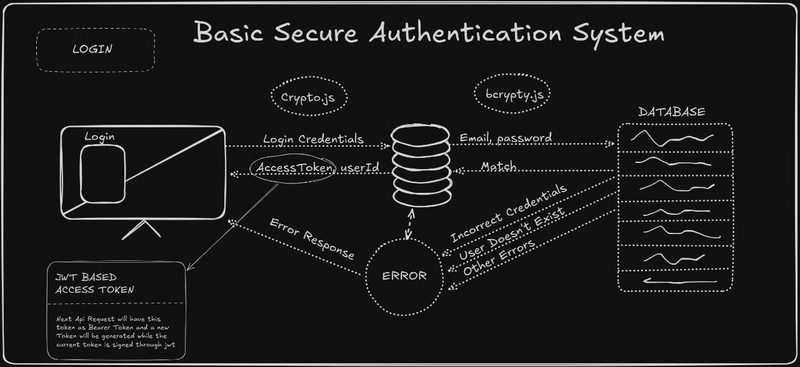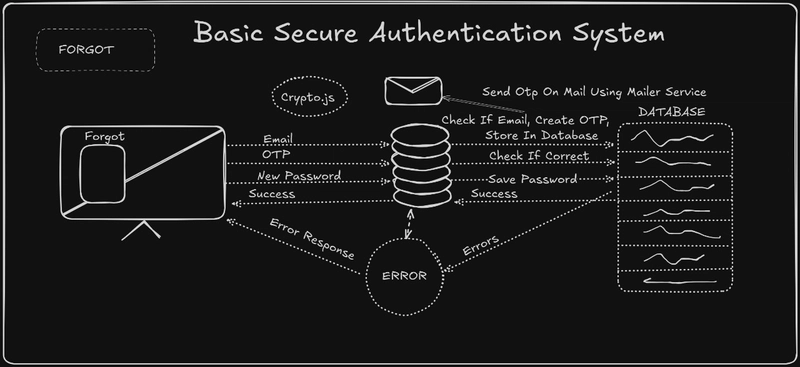Building a Secure Authentication System with Next.js and Nest.js
Security is a top priority in modern web applications, and a well-architected authentication system is key to protecting user data. In this guide, we’ll build a secure authentication system using Next.js and Nest.js, implementing Crypto.js, bcrypt, JWT, and role-based authentication. Additionally, we'll cover how to integrate NodeMailer for password reset functionality with OTP-based sessions.
Why This Architecture?
Our system follows a modular and layered security approach:
✅ Crypto.js (Frontend Encryption) – Encrypts credentials before transmission.
✅ bcrypt (Backend Encryption) – Hashes passwords before storing them in the database.
✅ JWT Authentication – Issues secure access tokens for API requests.
✅ Role-Based Access Control (RBAC) – Restricts users based on roles.
✅ OTP and NodeMailer for Password Reset – Provides secure session-based password recovery.
Step 1: Setting Up the Backend with Nest.js
1.1 Install Dependencies
In your Nest.js backend, install the required packages:
npm install @nestjs/jwt @nestjs/passport bcryptjs passport passport-jwt crypto-js nodemailer
1.2 User Entity & Authentication Service
Define the user schema in TypeORM:
import { Entity, Column, PrimaryGeneratedColumn } from 'typeorm';
@Entity()
export class User {
@PrimaryGeneratedColumn()
id: number;
@Column({ unique: true })
email: string;
@Column()
password: string;
@Column({ default: 'user' }) // Default role is 'user'
role: string;
}
Now, create the authentication service:
import * as bcrypt from 'bcrypt';
import { JwtService } from '@nestjs/jwt';
@Injectable()
export class AuthService {
constructor(private jwtService: JwtService) {}
async hashPassword(password: string): Promise<string> {
return bcrypt.hash(password, 10);
}
async comparePasswords(password: string, hash: string): Promise<boolean> {
return bcrypt.compare(password, hash);
}
async generateJWT(email: string, role: string) {
return this.jwtService.sign({ email, role });
}
}
Step 2: Implementing Crypto.js in the Frontend (Next.js)
To enhance security, we encrypt credentials before sending them to the backend.
2.1 Install Crypto.js
npm install crypto-js
2.2 Encrypt User Credentials in Next.js
Modify the login page (pages/login.js):
import CryptoJS from 'crypto-js';
async function login(email, password) {
const encryptedPassword = CryptoJS.AES.encrypt(password, process.env.NEXT_PUBLIC_SECRET).toString();
const response = await fetch('/api/auth/login', {
method: 'POST',
body: JSON.stringify({ email, password: encryptedPassword }),
});
const data = await response.json();
console.log(data);
}
Step 3: JWT-Based Authentication & Role-Based Access
3.1 Protect Routes Using JWT
Middleware for JWT authentication (jwt.strategy.ts):
import { Injectable } from '@nestjs/common';
import { PassportStrategy } from '@nestjs/passport';
import { ExtractJwt, Strategy } from 'passport-jwt';
@Injectable()
export class JwtStrategy extends PassportStrategy(Strategy) {
constructor() {
super({
jwtFromRequest: ExtractJwt.fromAuthHeaderAsBearerToken(),
secretOrKey: process.env.JWT_SECRET,
});
}
async validate(payload) {
return { email: payload.email, role: payload.role };
}
}
3.2 Role-Based Authorization Middleware
To allow access based on user roles, create a decorator:
import { CanActivate, ExecutionContext, Injectable } from '@nestjs/common';
@Injectable()
export class RolesGuard implements CanActivate {
canActivate(context: ExecutionContext): boolean {
const request = context.switchToHttp().getRequest();
return request.user.role === 'admin'; // Only admins can access
}
}
Apply the RolesGuard to protected routes:
@UseGuards(JwtAuthGuard, RolesGuard)
@Get('admin')
adminAccess() {
return "You have admin privileges!";
}
Step 4: Implementing Forgot Password with OTP & NodeMailer
4.1 Generate OTP and Send Email
Install NodeMailer:
npm install nodemailer
Create the email service:
import * as nodemailer from 'nodemailer';
@Injectable()
export class MailService {
private transporter = nodemailer.createTransport({
service: 'Gmail',
auth: {
user: process.env.EMAIL_USER,
pass: process.env.EMAIL_PASS,
},
});
async sendOTP(email: string, otp: string) {
await this.transporter.sendMail({
from: '"Security Team" <no-reply@example.com>',
to: email,
subject: 'Password Reset OTP',
text: `Your OTP is ${otp}`,
});
}
}
4.2 Store OTP in Database and Verify
Modify the AuthService:
import { v4 as uuidv4 } from 'uuid';
async requestPasswordReset(email: string) {
const otp = uuidv4().substring(0, 6); // Generate a 6-digit OTP
await this.userRepository.update({ email }, { otp });
await this.mailService.sendOTP(email, otp);
}
async verifyOTP(email: string, otp: string, newPassword: string) {
const user = await this.userRepository.findOne({ email });
if (user.otp === otp) {
user.password = await this.hashPassword(newPassword);
user.otp = null;
await this.userRepository.save(user);
return 'Password reset successfully';
} else {
throw new Error('Invalid OTP');
}
}
Final Thoughts
This authentication system ensures security at every layer:
🔒 Crypto.js encrypts credentials on the frontend.
🔒 bcrypt hashes passwords before storing in the database.
🔒 JWT tokens provide secure access.
🔒 Role-based access restricts sensitive data.
🔒 OTP-based password reset improves security.
With Next.js and Nest.js, we achieve a highly scalable, secure authentication system. 🚀




